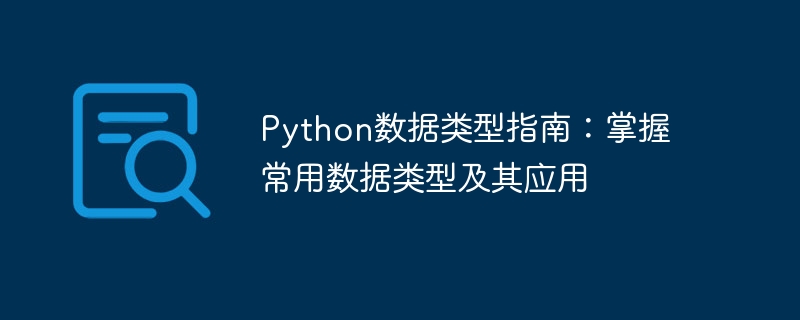Home >Backend Development >Python Tutorial >Python Data Type Guide: Master Common Data Types and Their Applications
Python Data Type Guide: Master Common Data Types and Their Applications
- WBOYWBOYWBOYWBOYWBOYWBOYWBOYWBOYWBOYWBOYWBOYWBOYWBOriginal
- 2024-01-20 08:32:151393browse

Python is a simple yet powerful programming language widely used for data analysis and scientific computing. To successfully use Python for data analysis, it is crucial to understand the different data types and their applications. This article will introduce commonly used Python data types and provide specific code examples.
- Number types (Numbers):
Number types in Python include integers (int), floating point numbers (float) and complex numbers (complex). Numeric types can be used for various arithmetic operations and mathematical calculations.
Code example:
x = 5 y = 2.5 z = 3 + 2j print(x + y) # 输出:7.5 print(x * y) # 输出:12.5 print(z.real) # 输出:3.0 print(z.imag) # 输出:2.0
- Strings:
A string in Python is a sequence of characters, enclosed in single or double quotes stand up. Strings are immutable and can be used to store text data.
Code example:
message = "Hello, World!"
name = "John"
age = 25
print(message) # 输出:Hello, World!
print("My name is " + name) # 输出:My name is John
print(f"I am {age} years old") # 输出:I am 25 years old- Lists:
List is one of the most commonly used data types in Python, used to store a series of ordered element. Elements in the list can be accessed through indexes, and operations such as adding, deleting, and modifying can be performed.
Code example:
fruits = ['apple', 'banana', 'orange']
print(fruits[0]) # 输出:apple
fruits.append('grape') # 添加元素
print(fruits) # 输出:['apple', 'banana', 'orange', 'grape']
fruits.remove('banana') # 删除元素
print(fruits) # 输出:['apple', 'orange']- Tuples:
Tuples are immutable lists that cannot be modified once created. Tuples can be used to store related values, such as coordinates or dates.
Code example:
point = (3, 4) date = (2021, 8, 15) print(point[0]) # 输出:3 print(date[1]) # 输出:8
- Dictionaries (Dictionaries):
Dictionaries are data structures that store key-value pairs, similar to dictionaries in real life. You can access the values in the dictionary through keys, and you can also add, delete, modify, etc.
Code examples:
student = {'name': 'John', 'age': 25, 'grade': 'A'}
print(student['name']) # 输出:John
print(student.get('age')) # 输出:25
student['age'] = 26 # 修改值
print(student) # 输出:{'name': 'John', 'age': 26, 'grade': 'A'}
student['country'] = 'USA' # 添加键值对
print(student) # 输出:{'name': 'John', 'age': 26, 'grade': 'A', 'country': 'USA'}The above is a brief introduction and code examples of commonly used data types and their applications in Python. Mastering the basic concepts and operations of these data types is very important for using Python for data analysis and scientific computing. I hope this article can help readers better understand and use data types in Python.
The above is the detailed content of Python Data Type Guide: Master Common Data Types and Their Applications. For more information, please follow other related articles on the PHP Chinese website!

